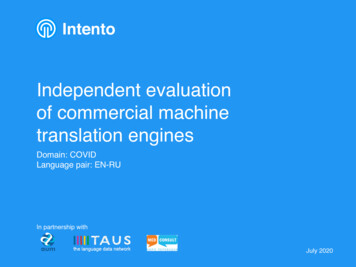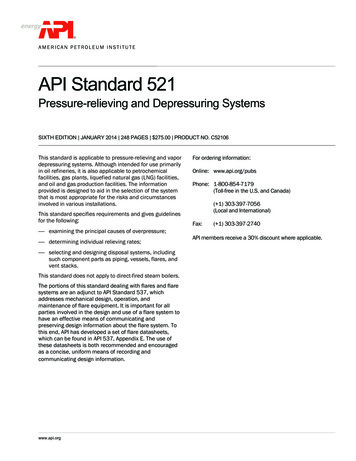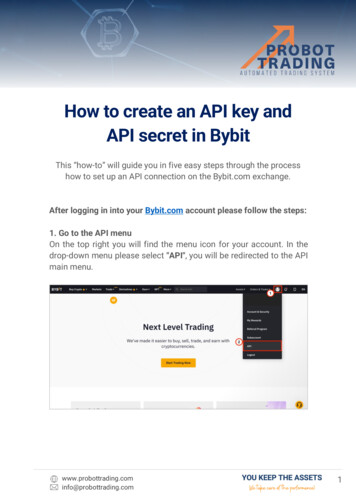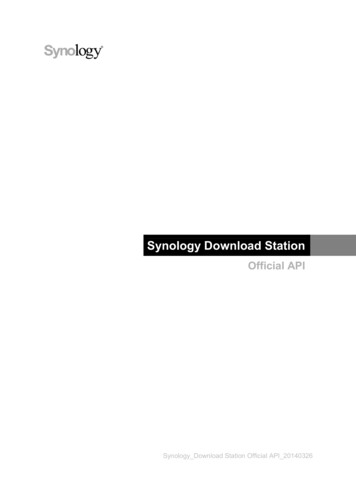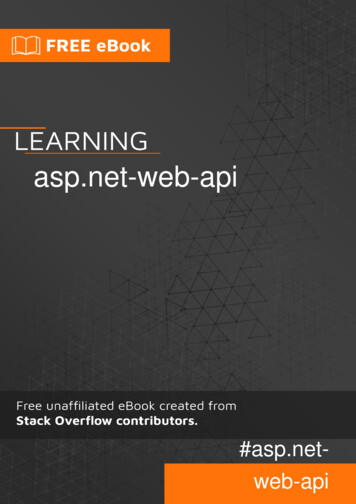
Transcription
Functional Requirements forTransport APIJune 10, 2016ONF TR-527
Functional Requirements for Transport APIVersion No.01ONF Document Type: Technical RecommendationONF Document Name: Functional Requirements for Transport APIDisclaimerTHIS SPEC IFICATION IS PROVIDED “ AS IS” W ITH NO WARRANTIESWHATSOEVER, INCLUDING ANY WARRANTY OF MERCHANTABILITY,NONINFRINGEMENT, FITNESS FOR ANY PARTICULAR PURPOSE, ORANY WARRANTY OTHERWISE ARIS ING OUT OF ANY PROPOSAL,SPECIFICATION OR SAMP LE.Any marks and brands contained herein are the property of their respective owners.Open Networking Foundation2275 E. Bayshore Road, Suite 103, Palo Alto, CA 94303www.opennetworking.org 2016 Open Networking Foundation. All rights reserved.Open Networking Foundation, the ONF symbol, and OpenFlow are registered trademarks of theOpen Networking Foundation, in the United States and/or in other countries. All other brands,products, or service names are or may be trademarks or service marks of, and are used to identify,products or services of their respective owners.Page 2 of 71 Open Networking Foundation
Functional Requirements for Transport API1Version No.01Introduction . 81.11.21.31.41.51.6Purpose . 8Scope . 9References . 9Abbreviations . 9Terms and Definitions . 10Conventions . 122Functional Architecture . 133Functional Requirements . 153.1 Topology Service . 153.1.1 Topology Retrieval APIs . 153.2 Connectivity Service . 173.2.1 Connectivity Retrieval APIs . 183.2.2 Connectivity Request APIs . 213.3 Path Computation Service . 233.3.1 Path Computation Request APIs . 233.4 Virtual Network Service. 253.4.1 Virtual Network Retrieval APIs . 253.4.2 Virtual Network Request APIs . 263.5 Notification Service . 273.5.1 Notification Subscription and Filtering APIs . 283.5.2 Notification Message Types . 313.6 TAPI Data Types . 324Appendix A: Transport API Concepts Overview . 384.14.24.34.44.54.65Appendix B: Transport API Examples Use cases . 505.15.25.35.45.56Context . 38Node and Topology Aspects of Forwarding Domain . 39Hierarchical Control Domains and Contexts . 42Topology Traversal using APIs . 44Service, Connection and Route . 46Node Edge Point v/s Service End Point v/s Connection End Point . 4810GE EPL Service over ODU2 Connection over 100G OTN network . 511G EVPL Service over ODU0 Connection over 100G OTN network . 54Var-rate EVPL Service over EVC Connection over 100G OTN network . 57EVPL Service with Load Balancing . 57Anycast EVPL Service . 58Appendix C: Multi-layer and Multi-domain Use cases . 606.1 Multi-layer and Multi-domain Topology Initialization . 606.2 Multi-layer and multi-domain services/connections . 61Page 3 of 71 Open Networking Foundation
Functional Requirements for Transport APIVersion No.016.3 Topology after service/connection Setup. 646.4 Further work . 657Appendix D: Transport API Information Model Skeleton . 668Contributors . 719Version History . 71List of FiguresFigure 1: T-API Artifacts - ONF/OSSDN Project Dependencies . 8Figure 2: Transport API Functional Architecture. 14Figure 3 : Simple Physical Network Example . 38Figure 4: Shared Contexts - Architecture perspective. 39Figure 5: Shared Contexts & Topology . 39Figure 6: Topological Decomposition of Node . 40Figure 7: Recursive Topological Decomposition of Node . 41Figure 8: Node/Topology perspectives of recursively partitioned Forwarding Domain (FD) . 41Figure 9: View of Controller-1 Context based on Views exported by Controllers 2 & 3 . 42Figure 10: Views of Controller-2 Contexts . 43Figure 11: Views of Controller-3 Contexts . 43Figure 12: API Client’s View of Controller-1 Context without retrieving Topology details . 44Figure 13: API Client’s View of Controller-1 Context by retrieving top-most level of Topology . 44Figure 14: API Client’s View of Controller1 Context by retrieving 2 levels of Topology details . 45Figure 15: API Client’s View of Controller-1 Context by retrieving 3 levels of Topology details . 45Figure 16: Service & Connections from Controller-1 perspective . 47Figure 17: Service & Connections from Controller-2 perspective . 47Figure 18: Service & Connections from Controller-3 perspective . 48Figure 19: Example Physical Network Topology . 50Figure 20: Example 10GE EPL Service over ODU2 . 52Figure 21: 10G EPL - Customer View of Connectivity . 52Figure 22: 10G EPL - Provider’s View of Topology exported to the Customer . 53Figure 23: 10G EPL - Provider’s View of Service/Connections exported to the Customer . 53Figure 24: 10G EPL - Customer's view of Service/Connectivity . 54Page 4 of 71 Open Networking Foundation
Functional Requirements for Transport APIVersion No.01Figure 25: Example 1G EVPL Service over ODU0 . 55Figure 26: 1G EVPL - Customer View of Connectivity . 55Figure 27: 1G EVPL - Provider’s View of Topology exported to the Customer . 56Figure 28: 1G EVPL - Provider’s View of Service/Connections exported to the Customer . 56Figure 29: 1G EVPL - Customer's view of Service/Connectivity . 57Figure 30: EVPL Service with Load Balancing. 58Figure 31: Example Anycast EVPL Service . 58Figure 32: Multi-layer and Multi-domain Example Network Configuration . 60Figure 33: Network Topology in Controller 1 . 61Figure 34: Multi-layer and Multi-domain service/connection setup (Option A) . 62Figure 35: Multi-layer and Multi-domain service/connection setup (Option B) . 64Figure 36: Topology instance diagram after service/connection setup . 64Figure 37: Transport API Information Model Skeleton . 66Figure 38: Topology Service Skeleton . 67Figure 39: Connectivity Service Skeleton . 68Figure 40: Virtual Network Service Skeleton. 69Figure 41: Path Computation Service Skeleton . 70List of Functional Requirement TablesTAPI FR 1: Get Topology List . 15TAPI FR 2: Get Topology Details . 15TAPI FR 3: Get Node Details . 16TAPI FR 4: Get Link Details . 16TAPI FR 5: Get Node Edge Point Details . 17TAPI FR 6: Get Service End Point List . 18TAPI FR 7: Get Service End Point Details . 18TAPI FR 8: Get Connectivity Service List . 18TAPI FR 9: Get Connectivity Service Details. 19TAPI FR 10: Get Connection Details . 20TAPI FR 11: Get Connection End Point Details . 20TAPI FR 12: Create Connectivity Service . 21TAPI FR 13: Update Connectivity Service . 22Page 5 of 71 Open Networking Foundation
Functional Requirements for Transport APIVersion No.01TAPI FR 14: Delete Connectivity Service. 22TAPI FR 15: Compute P2P Path . 23TAPI FR 16: Optimize P2P Path . 24TAPI FR 17: Get Virtual Network Service List . 25TAPI FR 18: Get Virtual Network Service Details . 25TAPI FR 19: Create Virtual Network Service . 26TAPI FR 20: Delete Virtual Network Service . 27TAPI FR 21: Discover Supported Notification Types . 28TAPI FR 22: Create Notification Subscription . 29TAPI FR 23: Modify Notification Subscription . 29TAPI FR 24: Delete Notification Subscription . 30TAPI FR 25: Suspend Notification Subscription . 30TAPI FR 26: Resume Notification Subscription . 30TAPI FR 27: Retrieve Notification Records . 30TAPI FR 28: Object Creation Notification . 31TAPI FR 29: Object Deletion Notification . 31TAPI FR 30: Attribute Value Change Notification . 31TAPI FR 31: State Change Notification . 32TAPI FR 32: Layer Protocol Name . 32TAPI FR 33: Capacity (Fixed Bandwidth) . 32TAPI FR 34: Capacity (Profile) . 33TAPI FR 35: Administration State . 33TAPI FR 36: Operational State . 33TAPI FR 37: Lifecycle State . 34TAPI FR 38: Port Role . 34TAPI FR 39: Port Direction . 34TAPI FR 40: Termination Direction . 34TAPI FR 41: Service End Point TRI format . 34TAPI FR 42: Service Type . 35TAPI FR 43: Connectivity Constraints . 35TAPI FR 44: Virtual Network Service Constraints . 35TAPI FR 45: Traffic Matrix . 36TAPI FR 46: Path Optimization Constraint . 36Page 6 of 71 Open Networking Foundation
Functional Requirements for Transport APIVersion No.01TAPI FR 47: Path Objective Function . 36TAPI FR 48: Notification-Header . 36TAPI FR 49: Notification-Type . 37TAPI FR 50: Object-Type . 37TAPI FR 51: Notification-Source-Indicator . 37Page 7 of 71 Open Networking Foundation
Version No.01Functional Requirements for Transport API1 IntroductionThe software defined networking (SDN) paradigm revolves around separation of forwarding/dataplane and control plane, logically centralized control and application-focused programmableinterfaces. In transport networks where logically-centralized control/management and controldata separation are not new concepts and the network-control function and behavior are wellunderstood and established, standardizing application programmer’s interfaces (APIs) to thenetwork control functions become important.1.1PurposeThe purpose of this document is to specify the information that is relevant to an applicationprogrammer’s interface (API) to transport network-control functions and serve as a“Functional Requirements Document” (FRD) document for the transport API work in ONF.Since the APIs are defined at interface boundaries and are intended to mask the need tounderstand the internal architectures on either side of the interface boundary, the focus has beento define purpose-specific use case scenarios from an application point of view treating the APIprovider as a “black box”. These application use cases have been used to drive the APIrequirements as well as to harmonize, generalize and normalize the API specifications. Tofacilitate the understanding of these requirements, some of the use cases are described in theappendices.Although these requirements are based upon several use cases that were deemed key for theapplication domain, the APIs have been developed with the intent of not precluding their beingemployed by additional valid application use cases.The requirements specified in this document are intended to drive the detailed UML informationmodel specifications, from which the YANG/JSON schema and Swagger APIs are generated.The following figure illustrates the inter-relationships between various T-API project artifacts:ONF-OTWGTAPI FRSUse cases & RequirementsONF-IMPONF Core InformationModelPruneRefactorTAPI UMLInformation ModelUML-YANG-JSONGeneration ToolONF TechnologySpecification ModelsOSSDNSNOWMASSYANG/JSON DataSchemaYANG-SWAGGERGeneration 52)MPLS-TP(ITU-TG.8152)ONF OTWG IMOpen ModelProfileOSSDN EAGLECodeTAPI PlatformAbstraction Layer &FrameworkOSSDN ENGLEWOODFigure 1: T-API Artifacts - ONF/OSSDN Project DependenciesPage 8 of 71 Open Networking Foundation
Functional Requirements for Transport API1.2Version No.01ScopeThis issue of the document specifies APIs for following transport network controller services:-Topology ServiceConnectivity ServicePath Computation ServiceVirtual Network ServiceNotification ServiceFor the purposes of this document, it is assumed that access control and policy details areconveyed via a distinct/orthogonal interface. It is understood that all API requests would besubject to filtering and scoping based on the privileges assigned to the calling entity and thesewould be based on business contracts as well as security and organizational roles. Application ofsuch policy constraints and filtering to the API requests and responses is out of scope for thisdocument. In other words, the API considerations in this document are from the perspective ofthe most privileged super-user.1.3ReferencesONF TR-512ONF TR-502ONF F2015.338.xxONF2015.323.xx1.4Core Information ModelSDN ArchitectureFramework for SDN: Scope and RequirementsSDN Notifications Framework (draft)Transport API IM ConceptsTransport API ExamplesState Information ModelLTP/End-Point e 9 of 71Application Programmer’s InterfaceInformation ModelOptical Transport Working GroupOptical Transport NetworkOperations, Administration and MaintenanceMPLS-Transport ProfileElement/Network Management SystemAutomatic Switched Optical Network/Generalized MultiProtocol Label SwitchingService Level AgreementNetwork ElementForwarding DomainNetwork Control DomainEnd PointLogical Termination PointTransport APITraffic Engineering DatabaseTransport Resource Identifier Open Networking Foundation
Functional Requirements for Transport API1.5Version No.01Terms and DefinitionsThis section defines some key terms that aid in understating the requirements. More informationis provided in the appendices and it is recommended that the reader familiarize themselves withthe basic concepts, constructs and use cases described in those sections.In general, the T-API uses terminology that is familiar to the transport network managementindustry, but maps to constructs defined in the ONF Core Information Model in form of purposespecific realizations. So it must be noted that these definitions are neither authoritative norexhaustive, and the reader should refer to the realized/mapped entities defined in ONF CoreInformation Model document.Also it should be noted that API IM relates to information exchanged over an interface and theentity definitions are intended to provide a logical structure for encapsulating information that isexchanged, and not intended to specify the information model patterns for implementations oneither side of the interface.Context (API Context)The T-API defines the scope of control, interaction and naming that a particular T-API provideror client application has with respect to the information exchanged over the interface. ThisContext is shared between the API provider and its client.Topology The T-API Topology is an abstract representation of the topological-aspects of aparticular set of Network Resources. It is described in terms of the underlying topologicalnetwork of Nodes and Links that enable the forwarding capabilities of that particular set ofNetwork Resources.NodeThe T-API Node is an abstract representation of the forwarding-capabilities of a particular set ofNetwork Resources. It is described in terms of the aggregation of set of ports (Node-Edge-Point)belonging to those Network Resources and the potential to enable forwarding of informationbetween those edge ports.LinkThe T-API Link is an abstract representation of the effective adjacency between two or moreassociated Nodes in a Topology. It is terminated by Node-Edge-Points of the associated Nodes.TE LinkThe T-API (Traffic Engineered)TE-Link1 is an abstract representation of the effective adjacencybetween two2 associated Nodes (or NodeEdgePoints) in a Topology, that has TE properties and isused in the description of the output of path computation APIs. It is terminated by Node-EdgePoints of the associated Nodes.12The TAPI TE-Link reflects the TE-Link as defined in the RFC-4202A TAPI Link could be a multi-point entity, with more than two end points.Page 10 of 71 Open Networking Foundation
Functional Requirements for Transport APIVersion No.01Node-Edge-PointThe T-API Node-Edge-Point represents the inward network-facing aspects of the edge-portfunctions that access the forwarding capabilities provided by the Node. Hence it provides anencapsulation of addressing, mapping, termination, adaptation and OAM functions of one ormore transport layers (including circuit and packet forms) performed at the entry and exit pointsof the Node.Service-End-PointThe T-API Service-End-Point represents the outward customer-facing aspects of the edge-portfunctions that access the forwarding capabilities provided by the Node. Hence it provides alimited, simplified view of interest to external clients (e.g. shared addressing, capacity, resourceavailability, etc.), that enable the clients to request connectivity without the need to understandthe provider network internals. Service-End-Point have a mapping relationship (one-to-one, oneto-many, many-to-many) to Node-Edge-Points.3Connection-End-PointThe T-API Connection-End-Point represents the ingress/egress port aspects that access theforwarding function provided by the Connection. The Connection-End-Points have a clientserver relationship with the Node-Edge-Points.Connectivity-ServiceThe T-API Connectivity-Service represents an “intent-like” request for connectivity between twoor more Service-End-Points. As such, Connectivity-Service is a container for connectivityrequest details and is distinct from the Connection that realizes the requestConnectionThe T-API Connection represents an enabled (provisioned) potential for forwarding (includingall circuit and packet forms) between two or more Node-Edge-Points of a Node. The T-APIConnection is terminated by Connection-End-Points which are clients of the associated NodeEdge-Points. As such, the Connection is a container for provisioned connectivity that tracks thestate of the allocated resources and is distinct from the Connectivity-Service request.Route (Connection Route)The T-API Route represents the route of a Connection through the Nodes in the underlyingTopology. It is described as a list of references to the underlying Connections.4PathThe TAPI Path is used to represent the output of path computation APIs and is described by anordered list of TE Links, either as strict hops (NodeEdgePoints) or as loose hops (Nodes).3Criteria for assigning/mapping ServiceEndPoints to NodeEdgePoints are out of scope of this FRD, but are typicallypart of implementation agreement (IAs) and some examples are provided by the use cases in the appendices.4The TAPI Connection Route is described in terms of Cross-Connections rather than Link-Connections.Conceptually a Connection Route is concatenation of Link Connections (resources associated with a Link) andCross-Connections (resources within the Nodes in the underlying Topology).Page 11 of 71 Open Networking Foundation
Functional Requirements for Transport APIVersion No.01Virtual Network ServiceThe T-API Virtual-Network-Service (VNS) represents a request for creation and offering of avirtual network Topology that maps two or more Service-End-Points, by an API-provider to anAPI client in accordance with agreements reached between them (e.g., satisfying the users’objectives). As such, Virtual-Network-Service is a container for virtual network Topology requestdetails and is distinct from the Topology that realizes the request.1.6ConventionsThis document uses the keywords "may" and "must" to qualify optional and mandatoryrequirements.Page 12 of 71
Figure 16: Service & Connections from Controller-1 perspective. 47. Figure 17: Service & Connections from Controller-2 perspective. 47 Figure 18: Service & Connections from Controller-3 perspective. 48. Figure 19: Example Physical Network Topology. 50 Figure 20: Example 10GE EPL Service over ODU2


